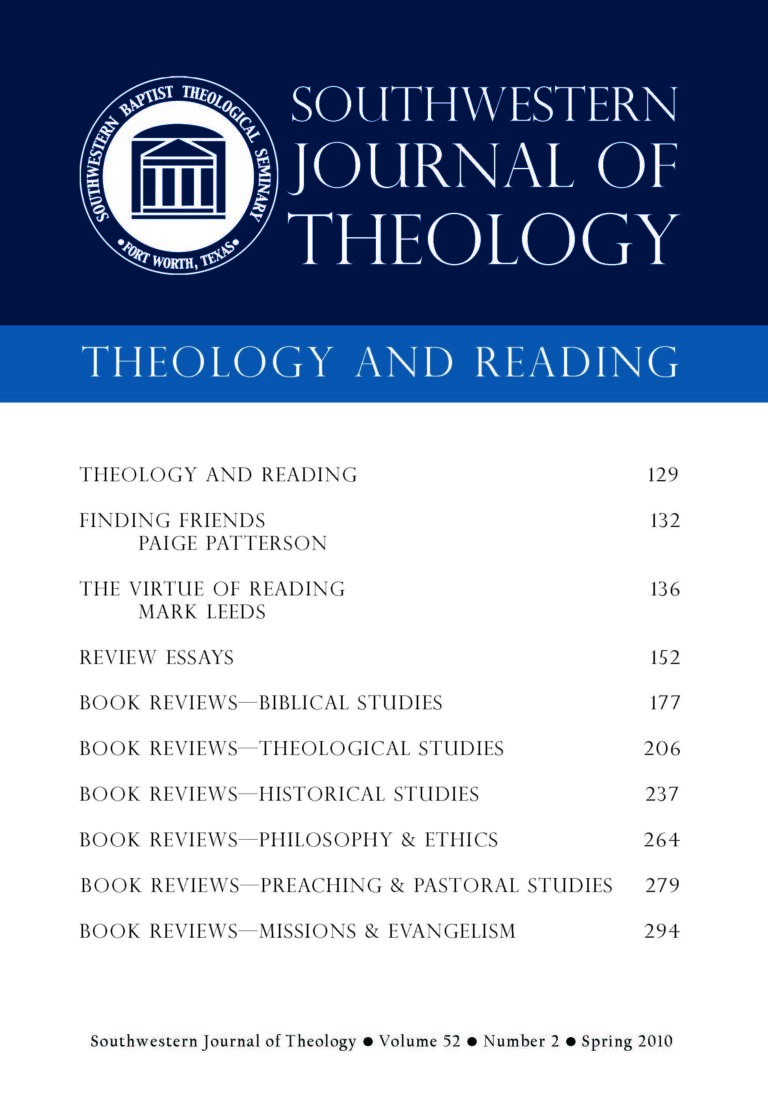
Theology and Reading
Southwestern Journal of Theology
Volume 52, No. 2 – Spring 2010
Managing Editor: Malcolm B. Yarnell III
By Helmut Koester. Minneapolis: Fortress Press, 2007. 301 + xv pages. Hardcover, $39.00.
Fifty years of published scholarly writings is an impressive and inspiring achievement. This volume is a collection of twenty-five articles by Helmut Koester, penned from 1955–2004 in the field of New Testament studies. Along with a yet- to-be-published subsequent volume of similar essays, this book represents half a century of research “to understand the New Testament and early Christianity in their historical development and contemporary environment” (279). Koester is the John H. Morrison Research Professor of Divinity and Winn Research Professor of Ecclesiastical History at Harvard Divinity School.
Section one primarily deals with 1–2 Thessalonians as representative of Paul’s letters. Koester plans to publish a commentary on these books soon, and this is his area of expertise (xv). Much of section two is an analysis of archeological discoveries in western Anatolia (Asia Minor in Paul’s day; Turkey today). These articles present a good paradigm of carefully examining archeological evidence and then making cautionary hypotheses about ancient life that fits the evidence. Koester primarily documents the wide geographic spread of Egyptian deities, which, interestingly, spread in the same geographic area that Christianity did (159). Section three is an eclectic group of articles on early Christianity.
Even if one does not agree with Koester’s liberal views, he deserves an audience. He presents some thought-provoking analyses, such as the observation that Thomas Jefferson, Ralph Waldo Emerson, and the Gnostic Gospel of Thomas all have an affinity for personal piety in the words of Jesus but miss: (1) the fuller salvific message and (2) the inclusive commandment of love (196, 198, 204–05). Yet, Koester’s call to “liberate Paul from the traditional interpretation” is a troubling appeal for universalism (206).
Since Koester is a trained Bultmannian form critic steeped in the historyof-religions school of thought, focusing on the alleged syncretism of both Judaism and Christianity (275), his non-traditional views should come as no surprise. Unfortunately, he reflects a low view of the New Testament canon, claiming other non-canonical writings, such as the Shepherd of Hermas and Apocalypse of Peter, are just as inspired as the rest of the New Testament (216). He claims the canonical Gospels are not inspired and that they are in the New Testament for church polity and catechetical purposes (218–19). Other problematic views include the following: 1) Jesus’ resurrection was only a new spiritual understanding by his followers rather than a literal resurrection (100–01—contrary to the literal, bodily resurrection affirmed in all four Gospels); 2) none of the Twelve authored a New Testament book (205—against the traditional views that Matthew wrote a Gospel, Peter wrote two epistles, and John wrote a Gospel, three epistles, and Revelation); 3) the Gospel of Thomas makes more claims to legitimate apostolic authority than do the four canonical Gospels (229—even though that writing is late, Gnostic, and not a Gospel); 4) Paul did not write 2 Thessalonians, Ephesians, Colossians, Philemon, and the Pastoral Epistles (253—contrary to Scripture testimony); and 5) Acts contains erroneous historical information regarding details of Paul’s journeys (256–57, 265—contrary to the historical veracity of the Old Testament & New Testament writings). Clearly, Koester approaches the biblical text with an anti-supernatural bias, as is evident in his firm belief that biblical “prophecy” must be written ex eventu (105).
Chapter twenty-five, “Insights from a Career of Interpretation,” was somewhat interesting but ultimately disappointing. Koester studied under an impressive array of theological luminaries: Fuchs, Bultmann, Bornkam, and Pannenberg (281). He notes how his emphasis shifted from Bultmann’s demythologizing of the New Testament “to a stage in my life where bringing archeologists and students of early Christianity together would occupy much of my time and seemed to me the most worthwhile thing I could contribute” (289). Yet, one wishes Koester offered more insights and examples of his theological pilgrimage than what he put into this chapter. As with the rest of the book, there is an abundance of knowledge but a lack of truly understanding the New Testament.





